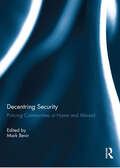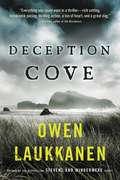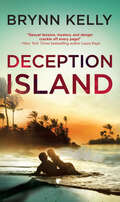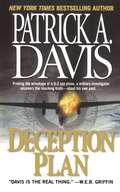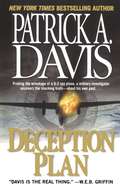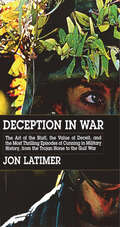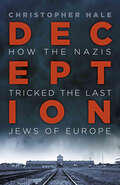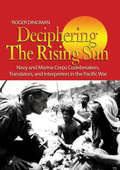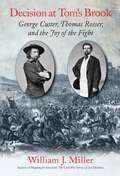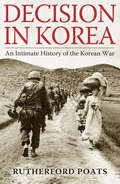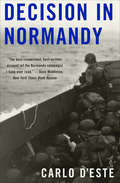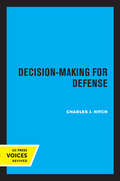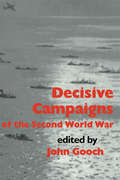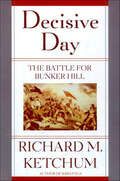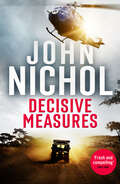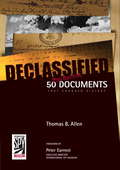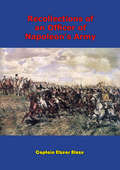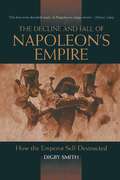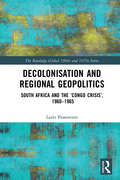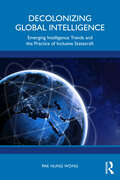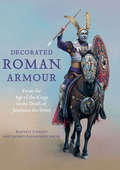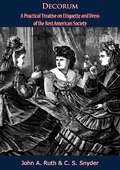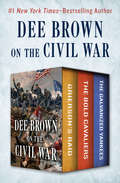- Table View
- List View
Decentring Security: Policing Communities at Home and Abroad
by Mark BevirContemporary security governance often relies on markets and networks to link public agencies to non-governmental actors. This book explores the rise, nature, and future of these new forms of security governance across various domestic, transnational, and international settings. The chapters reveal similarities and differences in the way security governance operates in various policy settings. The contributors argue that the similarities generally arise because policy elites, at various levels of governance, have come to believe that security depends on building resilience and communities through various joined-up arrangements, networks, and partnerships. Differences nonetheless persist because civil servants, street level bureaucrats, voluntary sector actors, and citizens all draw on diverse traditions to interpret, and at times resist, the joined-up security being promoted by these policy elites. This book therefore decentres security governance, showing how all kinds of local traditions influence the way it works in different settings. It pays particular attention to the meanings, cultures, and ideologies by which policy actors encounter, interpret, and evaluate security dilemmas. This book was originally published as a special issue in Global Crime.
Deception Cove: Neah Bay #01 (Neah Bay Book 1 #1)
by Owen LaukkanenFor fans of CJ Box and Michael Koryta, an "intimate and cinematic" thriller* about an ex-Marine, and ex-convict, and a rescue dog caught in the crosshairs of a ruthless gang in remote Washington state. Former US Marine Jess Winslow reenters civilian life a new widow, with little more to her name than a falling-down house, a medical discharge for PTSD, and a loyal dog named Lucy. The only thing she actually cares about is that dog, a black-and-white pit bull mix who helps her cope with the devastating memories of her time in Afghanistan.After fifteen years -- nearly half his life -- in state prison, Mason Burke owns one set of clothes, a wallet, and a photo of Lucy, the service dog he trained while behind bars. Seeking a fresh start, he sets out for Deception Cove, Washington, where the dog now lives. As soon as Mason knocks on Jess's door, he finds himself in the middle of a standoff between the widow and the deputy county sheriff. When Jess's late husband piloted his final "fishing" expedition, he stole and stashed a valuable package from his drug dealer associates. Now the package is gone, and the sheriff's department has seized Jess's dearest possession-her dog. Unless Jess turns over the missing goods, Lucy will be destroyed. The last thing Mason wants is to be dragged back into the criminal world. The last thing Jess wants is to trust a stranger. But neither of them can leave a friend, the only good thing in either of their lives, in danger. To rescue Lucy, they'll have to forge an uneasy alliance. And to avoid becoming collateral damage in someone else's private war, they have to fight back -- and find a way to conquer their doubts and fears.*Alex Segura, author of Blackout and the Pete Fernandez series
Deception Island (The Legionnaires #1)
by Brynn Kelly“Brynn Kelly pens a raw, dark, emotional novel of danger and intrigue that will keep readers turning the pages.” —Kat Martin, New York Times–bestselling authorRafe Angelito thought he was done with the demons from his past—until his son is kidnapped. Blackmailed into abducting an American heiress, the French Foreign Legionnaire soon finds himself trapped in paradise with a woman who’s nothing he expects . . . and everything he desires. But when he uncovers her own dark secret, Rafe realizes he’s made a critical mistake—one that could cost him everything. Playing body double for a spoiled socialite was supposed to be Holly Ryan’s ticket to freedom. But when she’s snatched off her yacht by a tall, dark and dangerous stranger, the not-quite-reformed con artist will make a desperate play to turn her captor from enemy to ally, by any means necessary. Yet as scorching days melt into sultry nights, Holly is drawn to the mysterious capitaine, with his unexpected sense of honor and his searing touch. When they’re double-crossed, they’ll have to risk trusting each other in ways they never imagined . . . because in this deadly game of deception, it’s their lives—and hearts—on the line.“Kidnappings and pirates and romance-oh my! Deception Island is a keeper.” —Cindy Gerard, New York Times–bestselling author“Intense and exciting . . . romantic suspense at its best!” —Carla Neggers, New York Times–bestselling author“Sexual tension, mystery, and danger crackle off every page!” —Laura Kaye, New York Times–bestselling author“A taut romantic thriller readers won’t want to put down.” —Library Journal (starred review)
Deception Plan
by Patrick A. DavisWHEN A U-2 SPY PLANE GOES DOWN IN A FIERY HEAP, THE PILOT'S DEATH IS A TRAGEDY -- BUT IT'S NO ACCIDENT. U. S. Colonel Ed Coffin is sent to South Korea, the land of his birth, to lead the most important and grim investigation of his career: a secret U-2 spy plane has crashed under highly suspicious circumstances. A former U-2 squadron commander, Coffin is teamed up with his former lover, the irrepressible OSI investigator Marva "Mother" Hubbard, and together they learn that the plane's pilot was specifically targeted for death -- but why? Navigating a geopolitical web strewn with murder, ambition, and betrayal, Coffin is soon embroiled in a desperate race for survival. But Coffin is also on another, more personal mission -- and one way or the other, it may be his last.
Deception Plan
by Patrick A. DavisWHEN A U-2 SPY PLANE GOES DOWN IN A FIERY HEAP, THE PILOT'S DEATH IS A TRAGEDY -- BUT IT'S NO ACCIDENT. U.S. Colonel Ed Coffin is sent to South Korea, the land of his birth, to lead the most important and grim investigation of his career: a secret U-2 spy plane has crashed under highly suspicious circumstances. A former U-2 squadron commander, Coffin is teamed up with his former lover, the irrepressible OSI investigator Marva "Mother" Hubbard, and together they learn that the plane's pilot was specifically targeted for death -- but why? Navigating a geopolitical web strewn with murder, ambition, and betrayal, Coffin is soon embroiled in a desperate race for survival. But Coffin is also on another, more personal mission -- and one way or the other, it may be his last.
Deception Plan
by Patrick A. DavisWHEN A U-2 SPY PLANE GOES DOWN IN A FIERY HEAP, THE PILOT'S DEATH IS A TRAGEDY -- BUT IT'S NO ACCIDENT. U.S. Colonel Ed Coffin is sent to South Korea, the land of his birth, to lead the most important and grim investigation of his career: a secret U-2 spy plane has crashed under highly suspicious circumstances. A former U-2 squadron commander, Coffin is teamed up with his former lover, the irrepressible OSI investigator Marva "Mother" Hubbard, and together they learn that the plane's pilot was specifically targeted for death -- but why? Navigating a geopolitical web strewn with murder, ambition, and betrayal, Coffin is soon embroiled in a desperate race for survival. But Coffin is also on another, more personal mission -- and one way or the other, it may be his last.
Deception in War: The Art of the Bluff, the Value of Deceit, and the Most Thrilling Episodes of Cunning in Military History from the Trojan Horse to the Gulf War
by Jon LatimerFrom the Trojan Horse to Gulf War subterfuge, this far-reaching military history examines the importance and ingenuity of wartime deception campaigns. The art of military deception is as old as the art of war. This fascinating account of the practice draws on conflicts from around the world and across millennia. The examples stretch from the very beginnings of recorded military history—Pharaoh Ramses II's campaign against the Hittites in 1294 B.C.—to modern times, when technology has placed a stunning array of devices into the arsenals of military commanders. Military historians often underestimate the importance of deception in warfare. This book is the first to fully describe its value. Jon Latimer demonstrates how simple tricks have been devastatingly effective. He also explores how technology has increased the range and subtlety of what is possible—including bogus radio traffic, virtual images, even false smells.Deception in War includes examples from land, sea, and air to show how great commanders have always had, as Winston Churchill put it, that indispensable &“element of legerdemain, an original and sinister touch, which leaves the enemy puzzled as well as beaten.&”
Deception: How the Nazis Tricked the Last Jews of Europe
by Christopher Hale‘I suppose you know who I am? I was in charge of the actions in Germany and Poland and Czechoslovakia. I am prepared to sell you one million Jews: Goods for blood … Blood for goods.’ These were the chilling words uttered by one of the most notorious Nazi bureaucrats, SS Colonel Adolf Eichmann, to a young Jewish businessman called Joel Brand in the spring of 1944. Brand embarked on a desperate mission to persuade the Allies to barter with Eichmann – and failed. At the same time, the SS deported hundreds of thousands of Hungarian Jews to Auschwitz-Birkenau packed in cattle trains. The majority were gassed, then incinerated. For decades after 1945, many blamed the Allies for callously abandoning a million Hungarian Jews to their fate. In Deception, Christopher Hale presents a new account of the ‘Brand Mission’ based on evidence in the national archives of Germany, Hungary, Britain and the United States. Hale reveals that Eichmann’s offer formed one part of a monstrous deception designed to outwit the leaders of the last surviving Jewish community in Europe. The deception was more complex and – from the German point of view – more successful than any operation mounted by the secret services of the Allied governments.
Deciphering the Rising Sun
by Roger DignmanThis book is the first to document the vital role played by Americans, not of Japanese ancestry, who served as Japanese language officers in World War II. Covering the period 1940-1945, it describes their selection, training, and service in the U.S. Navy and Marine Corps during the war and their contributions toward maintaining good relations between America and Japan thereafter. Author Roger Dingman argues that their service as codebreakers and combat interpreters hastened victory and that their cross-cultural experience and linguistic knowledge facilitated the successful dismantling of the Japanese empire and the peaceful occupation of Japan. He shows how the war changed relations between the Navy and academia, transformed the lives of these 1,200 men and women, and set onetime enemies on a course to enduring friendship. The book s purpose is twofold: to reveal an exciting and previously unknown aspect of the Pacific War and to demonstrate the enduring importance of linguistic and cross-cultural knowledge within America s armed forces in war and peace. The book is meant for general readers interested in World War II, as well as those with an interest in America's intelligence establishment and those fascinated by Japan and its relations with the United States. Based on extensive interviews with the language officers and on their wartime letters and unpublished memoirs, this history reveals how brains and a devotion to duty allowed these officers to learn an extraordinarily difficult language and use it to hasten Japan s defeat as well as to assist the transformation of the Japanese from enemy to friend of America. It is also, the author notes, a telling example of how empathy and cross-cultural understanding rather than brute force and coercion can lead to greater production of valuable intelligence and active collaboration.
Decision at Tom’s Brook: George Custer, Tom Rosser, and the Joy of the Fight
by William J. MillerThe Battle of Tom’s Brook, recalled one Confederate soldier, was “the greatest disaster that ever befell our cavalry during the whole war.” The fight took place during the last autumn of the Civil War, when the Union General Phil Sheridan vowed to turn the crop-rich Shenandoah Valley into “a desert.” Farms and homes were burned, livestock slaughtered, and Southern families suffered. The story of the Tom’s Brook cavalry affair centers on two young men who had risen to prominence as soldiers: George A. Custer and Thomas L. Rosser. They had been fast friends since their teenage days at West Point, but the war sent them down separate paths—Custer to the Union army and Rosser to the Confederacy. Each was a born warrior who took obvious joy in the exhilaration of battle. Each possessed almost all of the traits of the ideal cavalryman—courage, intelligence, physical strength, inner-fire. Only their judgment was questionable. Their separate paths converged in the Shenandoah Valley in the summer of 1864, when Custer was ordered to destroy, and Rosser was ordered to stop him. For three days, Rosser’s gray troopers pursued and attacked the Federals. On the fourth day, October 9, the tables turned in the open fields above Tom’s Brook, where each ambitious friend sought his own advancement at the expense of the other. One capitalized upon every advantage fate threw before him, while the other, sure of his abilities in battle and eager to fight, attempted to impose his will on unfavorable circumstances and tempted fate by inviting catastrophe. This long-overlooked cavalry action had a lasting effect on mounted operations and influenced the balance of the campaign in the Valley. Based upon extensive research in primary documents and gracefully written, award-winning author William J. Miller’s Decision at Tom’s Brook presents significant new material on Thomas Rosser, and argues that his character was his destiny. Rosser’s decision-making that day changed his life and the lives of hundreds of other men. Miller’s new study is Civil War history and high personal drama at its finest.
Decision in Korea
by Rutherford M. PoatsDecision in Korea, first published in 1954, is, as the author states, “a reporter’s survey” of the Korean conflict from its beginning through the first half year of the armistice. In scope, author Poats provides an excellent overview of the larger military and political aspects of the war, interspersed with personal stories of its fighting men and political leaders. Today, the book remains a useful, clearly written reference for explaining this confusing, tragic conflict. Rutherford Poats was head of the Japan bureau of the United Press and spent much time with United Nations forces in Korea during the fighting and peace-process. Included in this new edition are 4 maps and the complete text of the Armistice agreement.
Decision in Normandy
by Carlo D'EsteThe strategy and planning behind D-Day: &“The best-researched, best-written account [of the Normandy Campaign] I have ever read.&”—The New York Times Book Review One of the most controversial and dangerous military operations in the history of modern warfare, the battle for Normandy took over two years of planning by each country that made up the Allied forces. The event is mired to this day in myth and misconception, and untangling the web of work that led to D-Day is nearly as daunting as the work that led to the day itself. Drawing from declassified documents, personal interviews, diaries, and more, Carlo D&’Este, a winner of the Pritzker Award, uncovers what really happened in Normandy. From what went right to what went wrong, D&’Este takes readers on a journey from the very first moment Prime Minister Churchill considered an invasion through France to the last battles of World War II. With photos, maps, and first-hand accounts, readers can trace the incredible road to victory and the intricate battles in between. A comprehensive look into the military strategy surrounding the Second World War, Decision in Normandy is an absolute essential for history buffs. &“A fresh perspective on the leadership of Field Marshal Bernard Montgomery and the Allied landings after D-Day.&”—Publishers Weekly &“Again and again he reveals new facets of familiar subjects—in part from his own dual American army and British academic background; in part by querying everyone and everything.&”—Kirkus Reviews
Decision-Making for Defense
by Charles J. HitchWhen President Kennedy appointed Robert McNamara Secretary of Defense in January, 1961 and McNamara called on Charles Hitch to join him, a new era of defense policy leadership was clearly at hand. Great problems of organization had emerged along with vast increases in American responsibility for the security of the free world in the post-war era of rapidly changing military technology. Defense department unification and other controversial questions of organization of the defense establishment assumed new dimensions with the advent of the new techniques of planning and analysis. Hitch discusses, from the rare perspective of an analytically gifted insider, how the Department of Defense achieved balanced programs and more effective forces through the firm application of the new management techniques without sweeping changes of organization structure. Important challenges still lie ahead. As Hitch says: "The objectives, the organization, and the management techniques of national defense are all interrelated. Organization and procedures must be adapted to our changing nationaal policies and objectives as well as to changes in the character of our resources and technologies. It will take all our ingenuity and skill to make these necessary adaptations so that we can continue to provide unified management of so great an enterprise as our present military establishment. At the beginning of our Constitutional history the building of three frigates and the management of a few companies to fight Indians were considered too great a task for the War Department alone." Management of the American defense establishment has been a subject of fascination, concern and occasional despair to generation of Presidents, legislators, military leaders, and informed citizens. Hitch provides historical perspective on these tasks of decision-making for national security, and he explains clearly and succinctly the contemporary problems of fitting together strategic alternatives, weapons technology, and economic resources to achieve a rational pattern of defense management. The modern tools for this task are new techniques of planning, programming, and budgeting, and, for evaluating complex situations, the methods of systems analysis, all of which are discussed in detail. Hitch was involved both in the origination of these management techniques while at the RAND Corporation and in the tremendous task of putting them to consistent, far reaching, and practical use in the Department of Defense. President Johnson termed Hitch "a principal architect of America's modern defense establishment . . . It is largely as a result of [his] efforts that this country now possesses the most balanced, flexible, combat-ready defense force in history and management system to maintain our superior military posture and use it with precision." This title is part of UC Press's Voices Revived program, which commemorates University of California Press's mission to seek out and cultivate the brightest minds and give them voice, reach, and impact. Drawing on a backlist dating to 1893, Voices Revived makes high-quality, peer-reviewed scholarship accessible once again using print-on-demand technology. This title was originally published in 1965.
Decisions For War, 1914-1917
by Holger H. Herwig Richard F. HamiltonFocusing on the choices made by coteries, this study examines the perplexing question of why World War I happened. In each case, the decision to enter the war was made by a handful of individuals--monarchs, ministers, military people, party leaders, ambassadors, and a few others. In each case also, separate and distinct agendas are seen, with considerations differing from one nation to the next. The leadership of Japan, the Ottoman Empire, Italy, the Balkans, and the United States are explored, as well as that of the major powers involved--Austria-Hungary, Germany, France, and Great Britain,
Decisive Campaigns of the Second World War
by John GoochSuccess or defeat in the Second World War turned less on winning or losing battles than on winning or losing campaigns. This volume reassesses the importance of seven major campaigns for the outcome of the war. The authors examine a wide range of factors which influence success or failure including strategic planning, logistics, combat performance, command and military intelligence. This book represents a novel contribution to the study of the Second World War.
Decisive Day: The Battle for Bunker Hill
by Richard M. KetchumThe author of The Winter Soldiers recounts the early developments of the American Revolution and an important battle in Boston.Boston, 1775: A town occupied by General Thomas Gage’s redcoats and groaning with Tory refugees from the Massachusetts countryside. Besieged for two months by a rabble in arms, the British decided to break out of town. American spies discovered their plans, and on the night of June 16, 1775, a thousand rebels marched out onto Charlestown peninsula and began digging a redoubt (not on Bunker Hill, which they had been ordered to fortify, but on Breeds Hill, well within cannon shot of the British batteries and ships). At daybreak, HMS Lively began firing.It was the opening round of a battle that saw unbelievable heroism and tragic blunders on both sides (a battle that marked a point of no return for England and her colonies), the beginning of the Revolutionary War.
Decisive Measures
by John NicholA combat-weary helicopter pilot fights to save innocents from a bloody civil war in this &“fresh and compelling&” thriller(Daily Mail). Scarred by his experiences of war in the Balkans, pilot Jack Griffiths has found himself a seemingly routine job transporting supplies to a diamond mine in Sierra Leone. Soon, however, he is plunged headfirst into the crucible of a bloody civil war. In the midst of death and destruction, he must protect a group of people stranded in the middle—including Layla, a beautiful local doctor to whom he is powerfully drawn—in this rousing action thriller from the acclaimed author of Point of Impact. &“Nichol&’s writing skills are first rate.&” —Daily Express
Declassified: 50 Top-Secret Documents That Changed History
by Thomas B. AllenCulled from archives around the world, the 50 documents in Declassified illuminate the secret and often inaccessible stories of agents, espionage, and behind-the-scenes events that played critical roles in American history. Moving through time from Elizabethan England to the Cold War and beyond, noted author Tom Allen places each document in its historical and cultural context, sharing the quirky and little-known truths behind state secrets and clandestine operations. Each of seven chapters centers on one particular theme: secrets of war, the art of the double cross, spy vs. spy, espionage accidents, and more. Through support and access provided by the International Spy Museum in Washington, D.C., this lively history contains never-before-published and hard-to-find documents, printed from scans of the originals wherever possible. These include The Zimmerman Telegram, which led America into World War I; letters from Robert Hanssen to his Soviet spymaster, marking the start of his devastating career as a mole; and papers as recent as the Presidential Daily Brief that announced that Bin Laden was determined to strike the U.S., delivered in August 2001.
Decline And Fall Of Napoleon
by Field Marshal Viscount Garnet WolseleyThe Napoleon in power in later years may have lacked the absolute genius and resolution that his earlier campaigns displayed; however, he was more than a match for his enemies on more than one occasion. Field-Marshal Wolseley's short biography of Wellington begins in 1812, following the travails of Napoleon as he and the few survivors of the La Grande Armée trudged back from the Russian snows. As Napoleon feverishly combs depots for recruits, and conscripts more men for his army, he takes the fight to the Allies in Germany. But outnumbered, and demanding the impossible from his generals and troops, he is heavily defeated by the Allied forces. Pushed back to the borders of France, Napoleon contrives his finest campaign since the early Italian campaigns that gained him his fame. However, the number of allied forces eventually pushed him back, forcing his abdication and banishment to Elba. In the final throw of the dice, Napoleon returns to France and, despite some of his finest manoeuvring, is finally defeated at the battle of Waterloo."An admirable monograph, by the new Commander-in-Chief of the Forces,...giving in a crisp resume the last half of the career of Napoleon, ... Limited by space, there is yet a well-digested mass within these covers, clearly collated and tersely expressed..."-Theodore Aryault Dodge
Decline and Fall of Napoleon's Empire: How the Emperor Self-Destructed (World War Ii German Debriefs Ser.)
by Digby SmithUntil now, there has been no study of the significant errors that Napoleon made himself which, though apparently trivial at the time, proved to be major factors in his downfall. Digby Smith tracks his rise to power, his stewardship of France from 180415, and his exile. He highlights his military mistakes, such as his unwillingness to appoint an effective overall supremo in the Iberian Peninsula, and the decision to invade Russia while the Spanish situation was spiralling out of control.
Decolonisation and Regional Geopolitics: South Africa and the ‘Congo Crisis’, 1960-1965 (The Routledge Global 1960s and 1970s Series)
by Lazlo PassemiersDecolonisation and Regional Geopolitics argues that as much as the ‘Congo crisis’ (1960-1965) was a Cold War battleground, so too was it a battleground for Southern Africa’s decolonisation. This book provides a transnational history of African decolonisation, apartheid diplomacy, and Southern African nationalist movements. It answers three central questions. First, what was the nature of South African involvement in the Congo crisis? Second, what was the rationale for this involvement? Third, how did South Africans perceive the crisis? Innovatively, the book shifts the focus on the Congo crisis away from Cold War intervention and centres it around African decolonisation and regional geopolitics.
Decolonizing Global Intelligence: Emerging Intelligence Trends and the Practice of Inclusive Statecraft
by Pak Nung WongFrom September 11 to the calamitous withdrawal of United States troops from Afghanistan, Western intelligence has failed to negotiate the largest military and humanitarian crises across the world. This book proposes to decolonize global intelligence from the peripheries of the Global South and put forward a new intelligence practice of ‘inclusive statecraft’.It shows how dominant Western intelligence systems have failed to protect the very ideas they promised to uphold and the discrepancy between the West’s ‘Responsibility to Protect (R2P)’ liberalist doctrine and the realist on-the-ground complex reality as observed by the ‘Failure to Protect (F2P)’ scholarships. Drawing theoretical insights and empirical (both historical and contemporary) materials from a wide array of case studies of Western and non-Western intelligence settings and practices as well as their interactions, it argues that the next generation of global security and intelligence practitioners will necessitate genuine interracial, non-anthropocentric and cross-cultural inclusivity, especially the capability to take the non-Western intelligence cultures and their realist strategic thoughts seriously.This book will not just add new knowledge to the larger field of security and intelligence studies, but will also pioneer the relatively underdeveloped fields of comparative intelligence cultures, and interstellar intelligence/cultural studies. It will be indispensable for policymakers, bureaucrats and government officials.
Decorated Roman Armour: From the Age of the Kings to the Death of Justinian the Great
by Raffaele D'Amato Andrey Evgenevich NeginFrom the time of the Bronze Age, the warriors of all tribes and nations sought to emblazon their arms and armour with items and images to impress upon the enemy the wealth and power of the wearer. Magnificently decorated shields were as much a defensive necessity as a symbol of social status. Equally, decorative symbols on shields and armour defined the collective ideals and the self-conceived important of the village or city-state its warriors represented.Such items were therefore of great significance to the wearers, and the authors of this astounding detailed and extensively research book, have brought together years of research and the latest archaeological discoveries, to produce a work of undeniable importance.Shining Under the Eagles is richly decorated throughout, and as well as battlefield armour, details the tournament and parade armour from Rome's the earliest days.Dr Andrey Negin is candidate of historical sciences (Russian PhD), member of the department of history of the Ancient World and Classical Languages of Nizhny Novgorod State University named after N.I. Lobachevsky (Russian Federation). He has carried out fieldwork on ancient Roman armour and has published books and numerous articles on Roman military equipment.Dr Raffaele D'Amato is an experienced Turin-based researcher of the ancient and medieval military worlds. After achieving his first PhD in Romano-Byzantine Law, and having collaborated with the University of Athens, he gained a second doctorate in Roman military archaeology. He spent the last year in Turkey as visiting professor at the Fatih University of Istanbul, teaching there and working on a project about the army of Byzantium. He currently work as part-time researcher at the Laboratory of the Danubian Provinces at the University of Ferrara, under Professor Livio Zerbini.
Decorum: A Practical Treatise on Etiquette and Dress of the Best American Society
by John A. Ruth C. S. SnyderSo much has been written on the subject of etiquette and dress, that it would seem almost impossible to say anything new. In the preparation therefore of this work the author has drawn largely from all the best available authorities on the subject, believing that the combined thoughts and observations of the best thinkers and writers, would be far more valuable than anything emanating from the pen of any one person.No one however influential, or occupying a position however exalted, could presume to dictate rules for the conduct of others, and at the same time retain their esteem and friendship; for this reason the name of the author of this book is withheld. And yet, no one will question the necessity and utility of a work of this kind. Its object is not only to give the usages, of our best American society, to disregard which (though many of them seem—and are arbitrary) would subject the offender to the epithet of “ill bred,” but to impart that information by which anyone maybe enabled to acquire gentlemanly ease, or graceful ladylike deportment, so that their presence will be sought for, and they will not only learn that great art of being thoroughly at home in all societies, but will have that rarer gift of making everyone around them feel easy, contented and happy.
Dee Brown on the Civil War: Grierson's Raid, The Bold Cavaliers, and The Galvanized Yankees
by Dee BrownThree true tales of Civil War combat, as recounted by a #1 New York Times–bestselling author of Bury My Heart at Wounded Knee. The acclaimed historian of the American West turns his attention to the country&’s bloody civil conflict, chronicling the exploits of extraordinary soldiers who served in unexpected ways at a pivotal moment in the nation&’s history. Grierson&’s Raid: The definitive work on one of the most astonishing missions of the Civil War&’s early days. For two weeks in the spring of 1862, Col. Benjamin Grierson, a former music teacher, led 1,700 Union cavalry troops on a raid from Tennessee to Louisiana. The improbably successful mission diverted Confederate attention from Grant&’s crossing of the Mississippi and set the stage for the Siege of Vicksburg. General Sherman called it &“the most brilliant expedition of the war.&” The Bold Cavaliers: In 1861, Brig. Gen. John Hunt Morgan and his brother-in-law Basil Duke put together a group of formidable horsemen, and set to violent work. Morgan&’s Raiders began in their home state, staging attacks, recruiting new soldiers, and intercepting Union telegraphs. Most were imprisoned after unsuccessful incursions into Ohio and Indiana years later, but some Raiders would escape, regroup, and fight again in different conflicts. &“Accurate and frequently exciting&” (Kirkus Reviews). The Galvanized Yankees: The little-known and awe-inspiring true story of a group of captured Confederate soldiers who chose to serve in the Union Army rather than endure the grim conditions of prisoner of war camps. &“An accurate, interesting, and sometimes thrilling account of an unusual group of men who rendered a valuable service to the nation in a time of great need&” (The New York Times Book Review).
